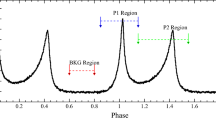Abstract
THE radio source 3C273 has been identified1,2 with a star-like object of about thirteenth magnitude having a faint jet. However, the optical spectrum of the star contains a number of broad emission features which can be explained as hydrogen, magnesium and oxygen lines with a red-shift δλ/λ0 of 0.158 (refs. 2 and 3). Schmidt suggests that the stellar object is either a nearby ultradense star or, more probably, the abnormally luminous nuclear region of a galaxy at a distance of about 500 megaparsecs. The second possibility would make 3C273 the most luminous object known.
Similar content being viewed by others
References
Hazard, C., Mackey, M. B., and Shimmins, A. J., Nature, 197, 1037 (1963).
Schmidt, M., Nature, 197, 1040 (1963).
Oke, J. B., Nature, 197, 1040 (1963).
McGee, R. X. (private communication).
Maltby, P., Matthews, T. A., and Moffet, A. T., Astrophys. J., 137, 153 (1963).
Robinson, B. J., Proc. Inst. Rad. Eng. (Austral.), 24, 119 (1963).
Author information
Authors and Affiliations
Rights and permissions
About this article
Cite this article
ROBINSON, B., VAN DAMME, K. & KOEHLER, J. 21-cm Absorption of the Radiation from 3C273. Nature 199, 990–991 (1963). https://doi.org/10.1038/199990b0
Issue Date:
DOI: https://doi.org/10.1038/199990b0
- Springer Nature Limited
This article is cited by
-
Quasistellare Radioquellen ? Dichtekrisen im Kosmos
Die Naturwissenschaften (1964)





